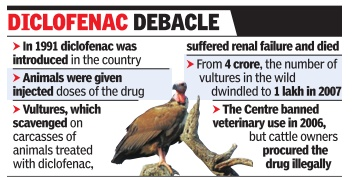Vulture conservation plan targets drug
National Board for Wildlife (NBWL)
- This statutory body is constituted under Wildlife Protection Act (WLPA), 1972.
- It is chaired by the Prime Minister and reviews all wildlife related matters. The NBWL has 47 members including the chairperson. Among these, 19 members are ex-officio members. Every new government constitutes a new board, based on the provisions of the WLPA, with the new PM as the chair.
- It is supposed to meet twice a year.
- It approves projects concerning in and around wildlife sanctuaries and national parks.
- The board is advisory in its nature regarding conservation of wildlife.
- Under WLPA, NBWL can have a standing committee which is chaired by the Minister of Environment, Forest and Climate Change.
- The Standing Committee’s function is to regulate land diversion within Protected Areas and Eco Sensitive Zones, making it a purely project clearance body. The NBWL, on the other hand, has the power to deal with policy-level decisions on wildlife
Diclofenac
- Diclofenac is a common anti-inflammatory drug administered to livestock (cattle and other domestic animals) and is used to treat the symptoms of inflammation, fevers and/or pain associated with disease or wounds. It was widely used in India beginning in the 1990s.
- But for vultures which eat dead cattle, are vulnerable to Diclofenac. This drug causes kidney failure in the vultures.
- Though the drug was banned in 2006, it is reportedly still available for use.

Vultures in India
- Vultures, by cleaning up carcasses and other organic waste in the environment, provide critically important ecosystem services that also directly benefit humans.
- India has 9 vulture species in the country. Most of their populations are declining.
- Three of India’s vulture species of the genus ‘Gyps’ below are under severe threat.
- The long-billed vulture (Gyps indicus) (Critically Endangered)
- The slender-billed Vulture (G. tenuirostris) (Critically Endangered)
- The white-rumped vulture (G. bengalensis) (Critically Endangered)
- The first two had declined by 97%, while the last one had declined nearly 99% between 1992 and 2007.
- Their decline is associated with use of drugs for cattle treatment which then end up in their digestive system making them vulnerable to kidney failure and poisoning.
Why in the news?
- NBWL has cleared an action plan namely ‘Action Plan for Vulture Conservation 2020-2025’.
- Under this plan, there is a proposal to establish Vulture Conservation Breeding Centres in the states of Uttar Pradesh, Tripura, Maharashtra, Karnataka and Tamil Nadu. These centres will be used to breed birds of Red Headed vulture and Egyptian vulture.
- It also recommends establishing at least one “Vulture Safe Zone” in every State for the conservation of the remnant populations.
- It also establishes 4 vulture rescue centres across India. They are :
- Pinjore in north India,
- Bhopal in central India,
- Guwahati in northeast India
- Hyderabad in south India
References:
- https://www.thehindu.com/news/national/wildlife-board-clears-plan-for-vulture-conservation/article33025074.ece
- https://www.downtoearth.org.in/news/wildlife-biodiversity/national-board-for-wildlife-hasn-t-met-even-once-since-2014-70374#
- https://en.wikipedia.org/wiki/Indian_vulture_crisis#:~:text=Diclofenac%20is%20a%20common%20anti,India%20beginning%20in%20the%201990s.

[…] https://officerspulse.com/vulture-conservation-plan-targets-drug/ […]